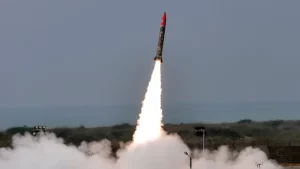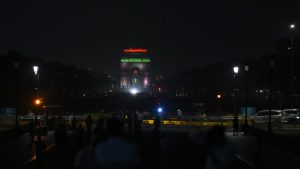New Delhi – In a dramatic escalation of hostilities between the two nuclear-armed neighbors, Pakistan launched a Fatah ballistic missile fired at Delhi, according to top government sources. The missile, identified as the Fatah-2, was successfully intercepted by Indian defense systems near Sirsa before it could reach the national capital. This development represents a significant intensification in the ongoing military confrontation that has seen both nations exchange airstrikes and drone attacks in recent days.
Fatah Ballistic Missile Fired At Delhi Intercepted in Sirsa
High-level government sources speaking to Channel6Network confirmed that a Fatah ballistic missile fired at Delhi was detected and neutralized by Indian air defense networks. The interception of the missile in Sirsa, approximately 215 kilometers northwest of Delhi, demonstrates India’s operational readiness and defensive capabilities amid the escalating conflict.

The Fatah-2 is an advanced ballistic missile system in Pakistan’s arsenal, capable of delivering conventional or potentially nuclear warheads with precision over medium ranges. The attempted strike using a Fatah ballistic missile fired at Delhi marks a significant elevation in Pakistan’s offensive posture, moving beyond the drone attacks and airstrikes that have characterized recent hostilities.
If confirmed officially, this attempted missile strike on India’s capital would represent one of the most serious attacks in the decades-long conflict between the two nations. Defense analysts suggest that the interception of the Fatah ballistic missile fired at Delhi will likely trigger a substantial Indian military response in the coming hours or days.
Technical Issues Hamper Pakistani Air Operations Following Fatah Ballistic Missile Fired At Delhi
According to intelligence reports, Pakistan has experienced significant technical difficulties with its air assets after launching the Fatah ballistic missile fired at Delhi. These complications may severely restrict Pakistan’s ability to conduct further offensive operations or defend against potential Indian counterstrikes.
Also Read: Pakistan Prepares for Counter Attack: Powerful Retaliation Under Operation Bunyan-Ul-Marsoos
Military sources indicate that following the launch of the Fatah ballistic missile fired at Delhi, Pakistani air defense networks have shown signs of degradation, potentially due to electronic warfare countermeasures deployed by Indian forces or technical failures in their systems.
While Pakistani military spokesperson Lt Gen Ahmad Sharif Chaudhry has maintained that “all Pakistani Air Force assets are safe,” independent verification remains challenging. The technical complications reported after the Fatah ballistic missile fired at Delhi suggest that Pakistan may have overstretched its military capabilities in this latest escalation.
Indian Drones Observed Over Pakistani Cities After Fatah Ballistic Missile Fired At Delhi
In what appears to be a direct response to the Fatah ballistic missile fired at Delhi, multiple Indian surveillance drones were reported hovering over major Pakistani cities including Islamabad, Rawalpindi, Sialkot, Lahore, and Peshawar. These unmanned aerial vehicles are likely gathering intelligence to assess Pakistani military readiness and identify potential targets for retaliatory strikes.


The presence of Indian drones over Pakistan’s key urban centers following the Fatah ballistic missile fired at Delhi indicates that India is actively preparing its response options. Military analysts suggest these drones may be conducting battle damage assessment from previous strikes while simultaneously gathering targeting data for future operations.
Pakistani air defense systems appear to have been ineffective at deterring these surveillance flights, possibly due to the technical issues reported after the launch of the Fatah ballistic missile fired at Delhi. This failure to secure Pakistani airspace represents a significant tactical advantage for Indian forces as tensions continue to escalate.
Retaliatory Indian Airstrikes Target Pakistani Military Installations Before Fatah Ballistic Missile Fired At Delhi
Prior to Pakistan’s launch of the Fatah ballistic missile fired at Delhi, India had already conducted extensive retaliatory strikes against targets in Islamabad, Lahore, and Rawalpindi. Defense sources told News18 that these operations specifically targeted three Pakistani Air Force bases: Nur Khan in Rawalpindi, Rafiqi in Shorkot, and Murid in Chakwal.
Multiple explosions were reported across Pakistani cities during these operations, with witnesses describing two distinct detonations in Rawalpindi and individual blasts in both Lahore and Islamabad. These strikes preceded the Fatah ballistic missile fired at Delhi and may have been intended to degrade Pakistan’s offensive capabilities.
Pakistani military spokesman Lt Gen Ahmad Sharif Chaudhry acknowledged these Indian operations but claimed that while India targeted key air bases, all Pakistani Air Force assets remained intact. This assertion contradicts intelligence reports suggesting significant damage to Pakistani air defense infrastructure before the Fatah ballistic missile fired at Delhi was launched.
Escalation Timeline Leading to Fatah Ballistic Missile Fired At Delhi
The current crisis has developed rapidly following the Pahalgam terror attack, which Indian authorities attribute to Pakistan-backed militants. This incident heightened tensions significantly, with both nations adopting increasingly aggressive military postures in the days that followed.
On Friday night and early Saturday morning, the situation deteriorated further as both countries exchanged airstrikes targeting military installations. These operations set the stage for the subsequent launch of the Fatah ballistic missile fired at Delhi, representing a dangerous new phase in the conflict.
Military analysts note that the progression from terror attacks to drone operations, then air strikes, and finally the Fatah ballistic missile fired at Delhi follows a concerning pattern of escalation. Each side has responded to provocations with increasingly powerful weapons systems, raising fears of a spiral toward potentially catastrophic outcomes.
Blackouts Implemented Across India Before Fatah Ballistic Missile Fired At Delhi


As a precautionary measure against potential attacks, including the Fatah ballistic missile fired at Delhi, Indian authorities implemented strategic blackouts across vulnerable regions. Jammu and Kashmir’s Akhnoor district experienced a complete blackout, with residents reporting both explosions and warning sirens in the area.
Similar measures were enacted in Jalandhar, Punjab, after drones were spotted in the vicinity. The District Commissioner issued a statement urging calm: “We have imposed a blackout for some time, as a few drones have been reportedly sighted in Jalandhar. Forces are checking. Please be calm and follow the blackout protocol.”
These preventive measures proved valuable when the Fatah ballistic missile fired at Delhi was detected, allowing defense systems to operate with minimal interference while reducing potential civilian casualties from any successful strikes. The blackout protocols form part of India’s comprehensive civil defense strategy during the ongoing conflict.
Widespread Pakistani Drone Activity Precedes Fatah Ballistic Missile Fired At Delhi
Before escalating to the Fatah ballistic missile fired at Delhi, Pakistan deployed numerous drones against Indian targets. Security sources reported Pakistani drones at 26 different locations spanning from Baramullah in the north to Bhuj in the south, targeting areas along both the International Border and the Line of Control.
These unmanned aerial vehicles were reportedly armed and posed threats to both civilian and military targets. In one particularly serious incident in Punjab’s Ferozpur, a drone attack seriously injured members of a local family, who subsequently received emergency medical assistance. Security forces have since secured and sanitized the affected area.
The widespread drone operations appeared designed to test Indian air defenses and create confusion before the launch of the Fatah ballistic missile fired at Delhi. By dispersing Indian defensive assets across a wide geographic area, Pakistani tacticians likely hoped to create vulnerabilities that could be exploited by subsequent missile strikes.
International Implications of Fatah Ballistic Missile Fired At Delhi
The launch of a Fatah ballistic missile fired at Delhi represents a significant escalation that has drawn immediate international concern. Military analysts note that ballistic missile attacks against major population centers cross traditional escalation thresholds and may invite stronger international intervention in the conflict.
Global powers have already expressed alarm at the rapidly deteriorating situation, with several nations calling for immediate de-escalation following reports of the Fatah ballistic missile fired at Delhi. United Nations Security Council members are reportedly consulting on an emergency session to address the crisis.
Defense experts suggest that the targeting of Delhi with a Fatah ballistic missile significantly increases the risk that India will respond with overwhelming conventional force. Some analysts fear this could push the conflict toward a potential nuclear dimension if further escalation occurs.
Strategic Analysis of the Fatah Ballistic Missile Fired At Delhi
The decision to launch a Fatah ballistic missile fired at Delhi represents a calculated gamble by Pakistani military leadership. By targeting India’s capital with a sophisticated ballistic missile system, Pakistan has demonstrated both capability and willingness to strike at the heart of Indian political and administrative power.
However, the successful interception of the Fatah ballistic missile fired at Delhi has revealed the effectiveness of India’s multi-layered air defense network. This defensive success may ultimately prove counterproductive for Pakistan, as it demonstrates the limitations of their offensive capabilities while potentially justifying a massive Indian response.
Military strategists suggest that the launch of the Fatah ballistic missile fired at Delhi may have been intended as a demonstration of Pakistan’s resolve rather than an attempt to cause maximum casualties. Nevertheless, even an unsuccessful ballistic missile strike against a capital city represents a significant act of aggression under international norms.
Final Word: Critical Juncture After Fatah Ballistic Missile Fired At Delhi
With a Fatah ballistic missile fired at Delhi and successfully intercepted, the India-Pakistan conflict has reached its most dangerous point in decades. Both nuclear-armed nations now face critical decisions about escalation management and potential pathways to de-escalation.
The coming hours will be crucial in determining whether the interception of the Fatah ballistic missile fired at Delhi leads to further military exchanges or creates space for diplomatic intervention. International pressure for restraint is mounting, though domestic political considerations in both countries may complicate efforts to reduce tensions.
As Indian military planners contemplate their response to the Fatah ballistic missile fired at Delhi, and Pakistan assesses the implications of the missile’s interception, the entire region remains on high alert. The possibility of miscalculation or unintended escalation presents a clear and present danger to regional stability and global security.

